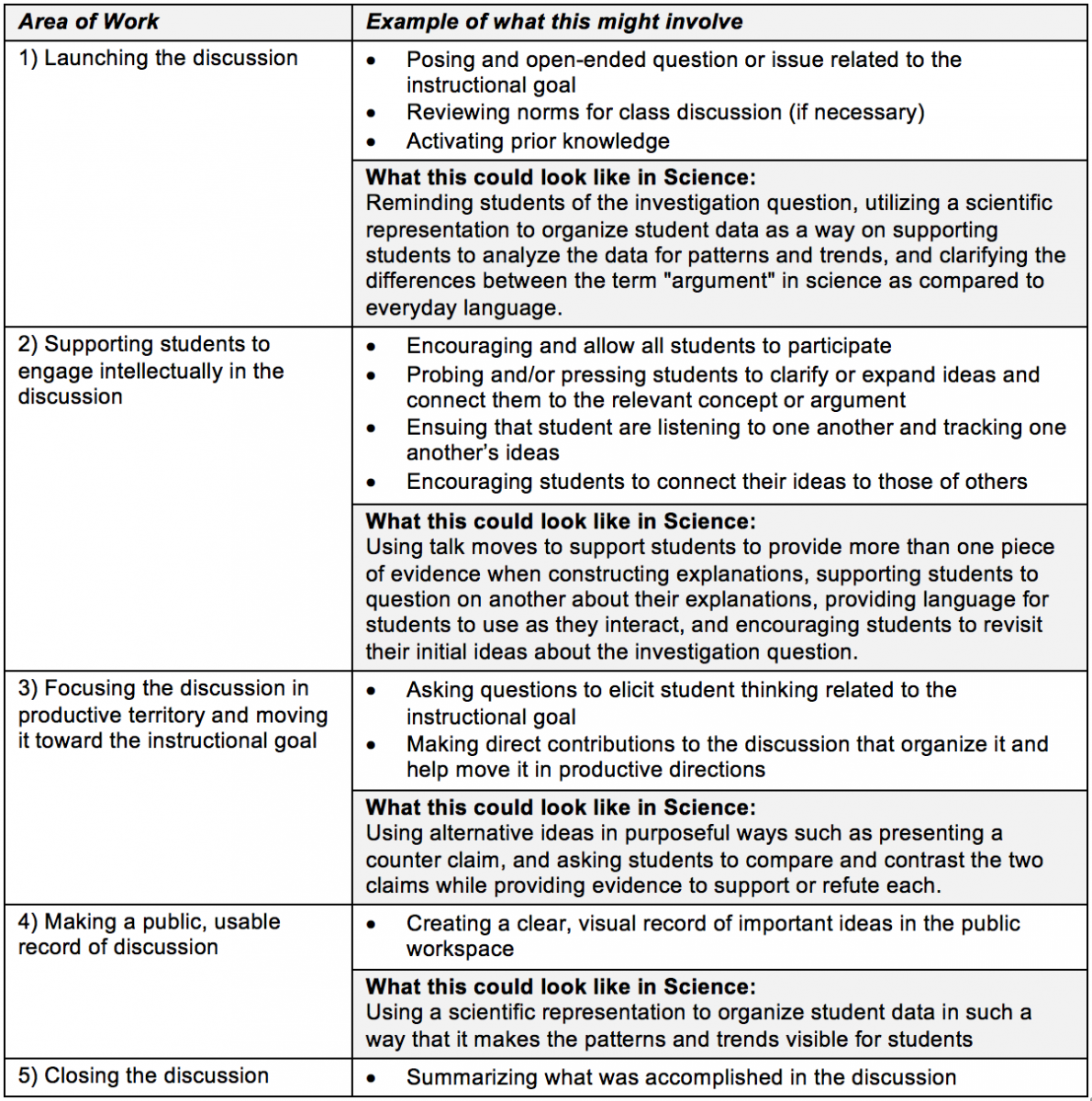What is leading a discussion in science?
In a group discussion, the teacher and all of the students work on specific content together, using one another’s ideas as resources and connecting disciplinary core ideas and scientific practices. The purposes of a discussion are to build collective knowledge and capability in scientific reasoning goals and to allow students to practice listening, speaking, and interpreting. The teacher and a wide range of students contribute orally, listen actively, and respond to and learn from others’ contributions.
In the classroom, this entails teachers providing support for students to make sense of scientific phenomena through the use of scientific representations to organize data collected during an investigation, crafting claims based on evidence and scientific reasoning, and engaging in argumentation. Through this process the teacher orchestrates student contributions by allowing space for all students to share their thinking. The teacher should also purposefully select students to share claims and counter-claims that support students to construct collective understanding of the scientific phenomenon and use talk moves to probe student thinking, and connect students’ ideas across the conversation.
Why work on leading a discussion in science?
By leading a group discussion in science, students are not only provided opportunities to share their ideas about science content but also supported to share what they think about other students’ ideas to progress toward a shared understanding of scientific phenomena. Sensemaking discussions centered around student ideas rarely occur in elementary science classrooms. When teachers enact investigation-based science lessons they have the potential to become solely hands-on activities despite research providing evidence that students discussing their ideas supports their learning. Therefore, it is important for novice teachers to learn how sensemaking discussions may differ from those they experienced in their own K-12 education. Leading a group discussion in science also supports students in engaging in the scientific practice of argumentation and is complemented by the high-leverage practices of eliciting and interpreting students’ ideas and supporting students to construct scientific explanations and build arguments.
How do teachers lead discussions in science?
For example, in a lesson on insulators and conductors of electric current, a teacher may collect groups’ data about which materials were able to complete a circuit. Then compiling the class date using a scientific representation, the teacher facilitates a discussion about how student observations can serve as evidence for a claim about what materials are conductors of electric current. During the discussion, the teacher probes student thinking with questions, and supports students to connect and compare their ideas.
What are the elements of the practice?
In science, the high-leverage practice of leading a group discussion is closely connected to the high-leverage practice of supporting students to construct scientific explanations and build arguments, thus there is overlap between the two resource guides. The “content point” of many whole-group science discussions is often a student-constructed scientific explanation. It is important that teachers support students to construct explanations and build arguments connecting to the scientific phenomena of focus for the investigation during a whole-class discussion.

How do we support novice teachers to learn this practice?
Whole-class sensemaking discussions that prioritize student contributions rarely occur in US classrooms. In some cases, novice teachers struggle to facilitate discussions because the novice lacks an in-depth understanding of the science content or knowledge of how to engage their students in the scientific practices of explanation construction or argumentation. Alternatively, because sensemaking discussions occur rarely, novice teachers may have had limited opportunities to experience sesemaking discussion in their own K-12 experiences or in their mentor teacher’s classroom. Rather, whole-class discussions in their experiences may follow an initiate-respond-evaluate (IRE) pattern between the teacher and a single student at a time. Finally, novice teachers often struggle to recognize the importance of using appropriate scientific representations to organize student data and launch an investigation-based discussion.
In working on this practice in teacher education, we provide opportunities for novice teachers to understand the potential of using scientific representations and practice using talk moves to elicit and probe student thinking, and connect and compare among students’ ideas. Additionally, we provide novice teachers opportunities to develop in-depth understanding of scientific phenomena and scientific practices of constructing explanations and engaging in argumentation. In our program we use the book What’s Your Evidence? Engaging Students in Constructing Explanations in Science by Zembal-Saul, McNeill, and Hershberger as a resource to support novice teachers to learn to facilitate investigation-based sensemaking discussions (see the Supporting Students to Construct Scientific Explanations and Build Arguments Resource Guide). The videos referenced here accompany the text but can be replaced with similar videos of experienced teacher practice.